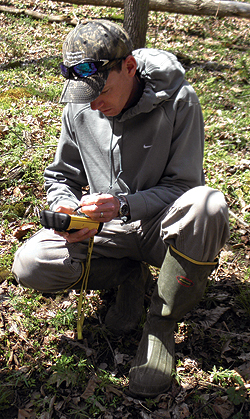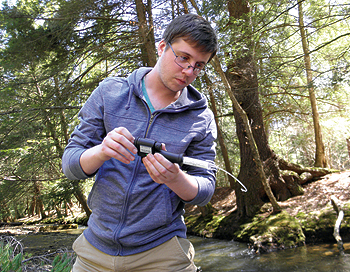Project Collects Baseline Data on State’s High-Value Places

Ryan Miller, WPC zoologist, gathers information at one of the sites being monitored by the Conservancy’s comprehensive study of habitats across the state.
Pennsylvania’s scenic ridges, expanses of forests and rippling streams contain many high-value conservation areas – places that are habitat for not only species of special concern, but also a number of globally rare species. A hiker in the state’s woodlands might spot the translucent wings of the West Virginia white butterfly. A visitor to a forest might hear the song of the black-throated green warbler. One could spot clumps of knee-high roan mountain sedge in Pennsylvania’s natural areas.
Thousands of feet below many of these valued areas stretch unseen, but also highly valued, resources. Nearly all of Western Pennsylvania is underlain by Utica and Marcellus Shale formations, estimated to contain billions of dollars of natural gas. But the surface areas contain critical habitat for plants and animals. In fact, more than 60 percent of the areas identified as important habitats by the Pennsylvania Natural Heritage Program’s (PNHP) County Natural Heritage Inventories are in the Utica and Marcellus Shale region. Of the hundreds of species tracked by PNHP, 714 are found in the shale gas regions.
“It’s unclear how shale gas development will impact Pennsylvania’s native biological diversity, plant and animal species and their habitat,” said Ephraim Zimmerman, ecological assessment manager at the Western Pennsylvania Conservancy. “We need to understand how rare species and their habitats are being impacted.”
The Conservancy is in the midst of a multiyear, comprehensive study of high-value conservation areas across the state, focusing on important habitats or areas that support rare species. Funded by a grant from the Richard King Mellon Foundation, the project examines the current ecological status of these places and gathers information that could help avoid or minimize the negative effects of industry work in the state’s most critical habitats. WPC scientists and staff members hope the results of the project can be used in monitoring shale gas activities as development expands across Pennsylvania. The results also could be used to guide conservation decisions on state and private lands.

Alex Rudowski, an AmeriCorps watershed technician, assesses the water quality at a high-value conservation site.
The lion’s share of the project’s planning and work is being done in-house. The first step of the project was to select sites for assessment and monitoring. The study sites fall into areas that not only had a high ecological and conservation value, but also had a likelihood of being impacted by Marcellus and Utica shale development.
Specifically, the team used a process called Ecological Value Analysis, a geographic information system (GIS) technique used in conservation planning activities that combines natural resource information into one geospatial layer. In this case, high conservation areas across the state were determined using aquatic and terrestrial habitat information, environmental quality data and rare plant and animal species occurrence data. Once all of the components were combined, the group selected sites within the top 10 percent ecological value range.
Next, the team assessed the selected areas’ potential for shale gas development. WPC staff found the relationships between existing and permitted natural gas well pad locations and variables that might be relevant to a company’s decision to drill a well. Those variables included shale formation depth and thickness, as well as the slope of the surface, the site’s distance to a water supply and a site’s distance to roads.
All the sites selected – 80 across the state – represent critical habitat for plant and animal species of special concern as identified by PNHP or for species listed in the state Wildlife Action Plan for Pennsylvania. A portion of the sites were selected for aquatic sampling and the rest are terrestrial sampling sites.
At the aquatic sites, researchers are visiting the sampling sites quarterly during the two-year assessment period and are measuring a number of conditions. Water samples are analyzed in a lab for standard elements associated with shale gas extraction, such as barium, chloride and bromide. They will also assess the level of aquatic macroinvertebrates, primarily insects living in water, which are used to determine the quality of aquatic systems.
WPC staff have surveyed terrestrial sites, assessing forest fragmentation and other issues that denote habitat quality. Researchers are also evaluating the abundance and diversity of forest interior dwelling bird species, such as the scarlet tanager (Piranga olivacea). Like the aquatic macroinvertebrates, the birds are indicators of habitat quality for forests.
At all of the sites, staff will place special emphasis on species that could experience declines because of water quality, forest and habitat fragmentation, noise and other factors associated with shale gas extraction.
“We hope our efforts will be used by policymakers, regulators, landowners, industry and conservation groups to adopt practices that avoid and minimize the impacts to high-value conservation area and the important species within them,” Zimmerman said.
